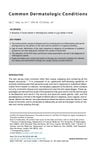Testosterone Metabolism in the Skin
November 1975
in “
Archives of dermatology
”
TLDR Increased DHT formation in skin can cause hair loss, acne, and excessive hair growth, and antiandrogens might treat these conditions.
The document reviewed the metabolism of testosterone in human skin and discussed the role of dihydrotestosterone (DHT) in androgenetic alopecia, acne vulgaris, and idiopathic hirsutism. It hypothesized that temporary increases in DHT formation at specific skin sites during different ages could lead to the development of normal sexual characteristics and androgen-dependent skin disorders. The potential for future treatments using antiandrogens was also considered based on recent studies.

